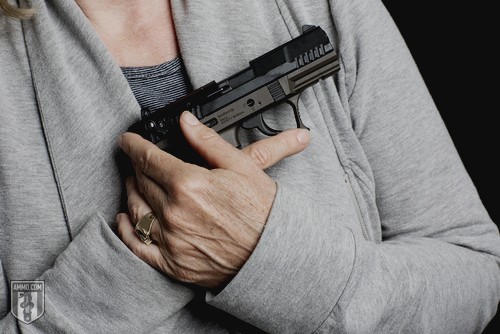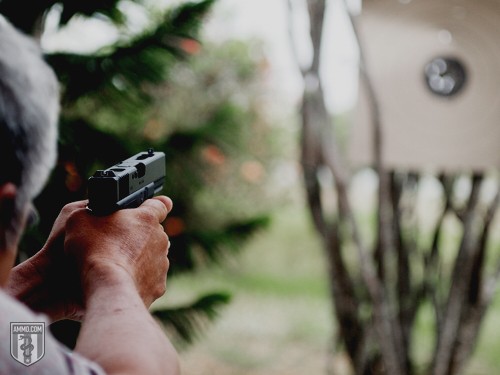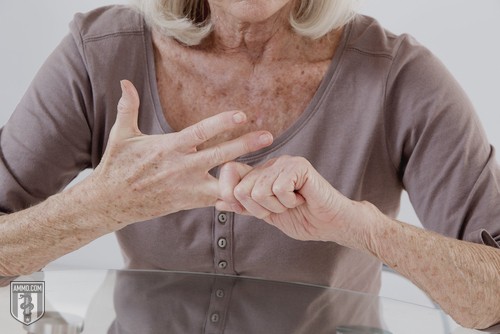Arming the Elderly: A Self-Defense Guide for Senior Citizens
You're free to republish or share any of our articles (either in part or in full), which are licensed under a Creative Commons Attribution 4.0 International License. Our only requirement is that you give Ammo.com appropriate credit by linking to the original article. Spread the word; knowledge is power!
 American seniors – those aged 65 and over – are growing in numbers. And thanks to medical and technological advances, our seniors are living longer than any previous U.S. generation. While these people have lived their lives and should be given the respect that age earns, too often they’re taken advantage of and made into victims of crime.
American seniors – those aged 65 and over – are growing in numbers. And thanks to medical and technological advances, our seniors are living longer than any previous U.S. generation. While these people have lived their lives and should be given the respect that age earns, too often they’re taken advantage of and made into victims of crime.
When it comes to purse snatching and larceny, seniors are disproportionately victimized compared to other age groups, with at least one in five personal crimes against seniors involving some sort of theft. As if that’s not enough, it’s not just crimes against the person that seniors fall victim to. They’re also more vulnerable to property crimes, especially burglary and vehicle thefts.
With more than 14 percent of seniors having experienced either physical, psychological or sexual abuse, neglect, or financial exploitation within the last year, it’s no wonder more and more people over the age of 65 are looking to up their self-defense and start carrying concealed. This guide highlights the importance of self defense for seniors and the steps they can take to better protect themselves.
Seniors Seem Like Easy Targets
One of the main reasons that seniors are so often victimized is that they seem like easy targets. And often times they are. Many aging individuals have physical and mental limitations, and can be seen as slow, frail, and less likely to put up a fight. They don’t have good reaction times, eyesight or hearing, and most can’t run away if they tried.
In addition to many seniors living alone, and a growing number with family that moved away, it’s easy for con artists and scammers to move in and not be noticed. Seniors are also more likely than other cohorts to have a nest egg at home – whether in cash, jewelry or valuable items – which makes them alluring to criminals and thugs.
Avoid Being a Target
Yes, seniors are old. And yes, they may not move as fast as their younger counterparts. But that doesn’t mean they’re not capable of self-defense. The first thing to learn about self-defense and how to avoid being targeted by criminals is that you have to be aware of your surroundings.
When you pay attention to what’s going on around you, you’re less likely to find yourself in a self-defense situation. If victims had been more aware of their surroundings, the circumstances could have been avoided.
Here are self-defense techniques for seniors that can lessen your risk of being victimized. And remember, it’s always better to avoid trouble than confront it.
- Walk with purpose.
- Keep your eyes up.
- Know where the exits are.
- Watch for suspicious people.
- Avoid places that are known to be unsafe.
- Don’t go places alone.
- Run errands during the day.
- Don’t linger in isolated places.
- Don’t be distracted.
- Stay in well-lit areas.
- Always be aware of your surroundings.
- Keep your keys in your hand, ready to go.
Don’t Be Overly Trusting
One of the things that makes seniors easy prey for perpetrators is the fact that they are often more trusting than younger folks. While it’s always nice to give people the benefit of believing they’re good, don’t do it with a blind eye. Here are ways to avoid being overly trusting and putting yourself and your property at risk.
- Never open your car or house door to a stranger. If they need to borrow the phone, leave them on the porch.
- If someone starts moving toward you asking for help, tell them right away you can’t help them and keep moving.
- Don’t give out unnecessary personal information. No one needs to know your street address (saying you live in Chicago is close enough). And if they ask whether your children live locally, always say yes – even if they’re halfway around the world.
- Never allow someone to take you to another location. If you’re in an attacker situation, fight to stay where you are. Once you leave, chances are that the danger will increase.
A Few Tips
- If you’re carrying groceries or laundry, use a luggage cart or pull behind. This keeps your hands free and makes you less likely to be attacked.
- Instead of carrying around $1,000 in cash and 10 credit cards in your wallet, only carry what you need. That way if your wallet is stolen, the criminal didn’t get everything.
- Carry a travel wallet instead of your regular wallet. It keeps your valuables hidden and isn’t accessible to pickpockets and other thieves.
- For women who carry purses, consider wearing it on the inside of your jacket instead of the outside. This makes it less visible and harder to reach if someone tried to snatch it.
- Improve your chances of evading criminals by staying active and fit. Seniors who live active lifestyles are faster, stronger, and have quicker reaction times than their peers.
Learn to Protect Yourself
 Just because you’re post-retirement doesn’t mean you can’t protect yourself – you just have to learn how. When you were younger, you may have been able to hold your own with your fists, but now that you’re older, that’s not going to cut it. Now you’ve got to learn how to fight back when in an attacker situation, using what’s available.
Just because you’re post-retirement doesn’t mean you can’t protect yourself – you just have to learn how. When you were younger, you may have been able to hold your own with your fists, but now that you’re older, that’s not going to cut it. Now you’ve got to learn how to fight back when in an attacker situation, using what’s available.
Remember, you have the element of surprise on your side.
Use What You Have
When it comes to self-defense, you need to use whatever is available to protect yourself. If there’s a canvas bag in your hand, swing it at the perpetrator's head. If you’re pushing a cart, get it between you and the attacker. Regardless of what you have, it’s better than nothing and some things can do some pretty massive damage.
- Purse: Even though it’s what many attackers try to grab, a purse can be a heck of a weapon. Get a good swing and crack them in the side of the face. It may not knock them out, but it sure will stun them.
- Cane: If you walk with a cane, you’ve already got a handy weapon. Use it like a staff for defense or offensive moves. Or if it has some girth to it, swing it like a club. Some communities even offer self defense classes for seniors, specifically for those with canes.
- Keys: Learn to walk with your fist wrapped around your keys with one key sticking out between your knuckles. This gives you a solid, makeshift weapon that can be used as a knife to slice or puncture.
Carry a Few Extras
If you want to up your protection without having to go to lethal extremes, pick up a few extras to carry with you or leave in your car or nightstand. One of these may be enough to stop a perpetrator from pursuit and make him turn around to find someone else.
- Police whistle
- Flashlight
- Mace
- Personal alarm
Take a Class
There’s a vast range of self-defense classes out there and many are specific to seniors. These classes are designed to address the specific challenges seniors face when in self-defense situations. Some fitness centers and senior facilities are even teaching Cane Fu, a blend of martial arts that teaches seniors how to use their cane to protect themselves.
If there are no senior-specific self-defense classes in your area, don’t fret. Sign up for a regular self-defense or martial arts class – just look for a course with slower, gentler movements. Classes like AiKido or Wing Chun don’t require as many quick moves or bending to the floor as other practices, and therefore tend to be more beneficial to seniors.
A Few Tips
- If you’re interested in using martial arts to help protect yourself, consider taking a course in T’ai Chi. Although it’s not designed for self-protection, it teaches you how to move your body and gets your muscles accustomed to the movements of other martial arts.
- Do what you can to avoid a fight. Get loud. Blow a whistle. Tell the attacker to leave. It will show him that you’re not a meek old person who’s going to just stand by and become a victim.
- Stay out of reach. If an attacker asks for your bag, don’t hand it to him, throw it at his feet. If he reaches for your arm, back up and yell, “Don’t touch me.” Once he gets his hands on you, it’ll be harder to get away.
- Always avoid hand-to-hand combat if you can. But if you find yourself in a situation where it can’t be avoided, defend and attack with short, sharp jabs and knee thrusts.
- Fight as dirty as you can. Poke your attacker in the eye. Punch him in the nose. If you can, knee him in the testicles. Nothing is off limits when you’re fighting for your life.
- Never let an attacker back you into a wall. Instead of moving backwards, move to the side or forward.
- If you’re attacked from behind, lean back onto the perpetrator and throw your head back hard. This will catch him off guard and throw off his balance.
Carrying a Concealed Weapon
 Only you can decide if carrying concealed is the right thing to do. Some people are okay with carrying a firearm, while others can’t imagine being comfortable holding one – let alone shooting it. Either philosophy is okay, but it’s important to understand that a concealed carry handgun gives you a level of protection that nothing else can.
Only you can decide if carrying concealed is the right thing to do. Some people are okay with carrying a firearm, while others can’t imagine being comfortable holding one – let alone shooting it. Either philosophy is okay, but it’s important to understand that a concealed carry handgun gives you a level of protection that nothing else can.
If you decided to carry, here are three of the most important things for seniors to consider when carrying a concealed firearm:
- Have the right weapon.
- Be comfortable with it.
- Be willing to do what it takes.
Have the Right Weapon
Even if a .45 mag was your go-to weapon when you were 30, it doesn’t mean it’s what you should reach for when you're 80. Having a weapon that you can handle, both in manual dexterity and in strength, is essential when it comes to carrying concealed for self-defense. Be sure you can keep it under control, handle the recoil, and have a smooth trigger pull.
Be Comfortable With the Weapon
Having the right gun is only half the battle. You’ve got to know how to handle the gun and be confident in your abilities. Your gun needs to become an extension of you and that only happens with regular and continued practice.
Yet, you’ve got to do more than shoot your firearm at the range. You need to practice drawing it from the holster and pulling it up to sight. You’ve got to practice shooting from different angles, including from standing and from the floor. And you need to become accustomed to shooting your weapon with both hands, as you never know what’s going to happen in a self-defense situation.
Be Willing to Do What it Takes
While just drawing a handgun on an attacker may be enough to scare some perpetrators, it won’t scare them all. That means if you’re going to carry concealed, you need to be willing to do what it takes to protect yourself – including pulling the trigger. Otherwise, you’ve just provided your attacker with a deadly weapon that he can turn around and use on you.
Find the Right Holster
If you’re going to carry concealed, you’re going to need a holster or harness. It’s unsafe to carry a loaded firearm loose in your pocket or jammed into the waistband of your pants. A holster keeps you and your handgun safe – as well as stores it in the same place every single time, making drawing easier and more consistent.
Picking the Right Firearm
 There’s no right firearm for seniors, especially when it comes to concealed carry. Each person may need to try a handful of guns before finding the one that feels right in their hand and on their hip.
There’s no right firearm for seniors, especially when it comes to concealed carry. Each person may need to try a handful of guns before finding the one that feels right in their hand and on their hip.
Semi-Automatic Pistols
Although many believe it’s best to carry a semi-automatic pistol, many aging individuals don’t have the dexterity or hand strength to pull back the slide. If you find a piece with an easy-to-handle slide, also be sure to check the safety mechanisms and the magazine clip to ensure you have the fine motor skills and strength to operate both.
A few good options include:
Revolvers
While a revolver has the benefit of no slide and no intricate safety mechanisms to be concerned with, you do need to be sure you have the finger strength for the long pull. It’s important to note that the long trigger pull serves as the revolver’s safety, especially if you have grandchildren around.
A few good options include:
- Ruger SP101 .327 Mag
- Smith & Wesson J-Frame in any caliber
Small Guns
Small-caliber guns like .22s are never recommended for self-defense. While they’re easy to carry and shoot, they just don’t have enough power to stop an attacker in his tracks. But, and this only applies to seniors, if you cannot handle a gun larger than a .22, carrying a small gun is better than no gun at all.
To get the most power and reliability from a small-caliber gun, try the .22LR or .22 mag mini-revolvers by North American Arms. They’re the safest way to go small.
Overcoming Obstacles and Limitations
 The best thing you can do when it comes to overcoming obstacles and limitations is know exactly what those limitations are. That way, you can prepare for them and know what to expect when faced with a deadly situation.
The best thing you can do when it comes to overcoming obstacles and limitations is know exactly what those limitations are. That way, you can prepare for them and know what to expect when faced with a deadly situation.
Some common limitations that get in the way of senior self-defense include:
- Bone and muscle stiffness
- Arthritis
- Limited range of motion
- Weight gain
- Postural imbalance
- Slow moving
- Poor eyesight
- Bad hearing
- Tremors
- Chronic pain, including back, hips, shoulders, knees and neck
When You Have Limited Motion
When you can’t reach behind you without wincing in pain, drawing a handgun from a hidden holster suddenly feels like you need a chiropractor to make it happen.
Instead of trying a shoulder holster, use a snap-on or clip holster and wear it on your dominant hip. Be sure to check the snaps beforehand to ensure you can open them easily. Many are extremely difficult, especially when they’re new.
When You Have Limited Hand Strength
If your hand strength is limited, you’re going to experience a few complications. First, with a semi-automatic, you will need to make sure the firearm’s slide is easy enough for you to move. Try a semi-automatic with a tip-up barrel, such as the Beretta .32 Tomcat, to eliminate this problem (at least for the initial round).
The alternative is to go with a revolver, but if your finger strength is weak, there may be difficulty with the trigger pull.
When You Have Posture Imbalance
The most important thing to consider when carrying concealed with balance issues is having a weapon that’s light enough to handle. While a heavy .357 may look nice, it’s going to be too powerful and heavy of a weapon for you to manage during a self-defense situation.
To remedy this, consider wearing a snug shoulder holster instead of a hip holster. This makes reaching the gun easier and won’t throw you off balance as you reach across your body. Another option is to carry a small gun and wear a pocket holster.
When You Have Chronic Pain
Whether it’s in your back, neck or hips, chronic pain can make carrying a concealed weapon difficult. The important thing to remember is to keep your firearm light so it doesn’t impact your balance or make you modify your gate.
To lower the chance of pain, choose a holster that fits low and snug on the hip. You won’t have to reach high or back, both of which can be difficult for those with chronic pain.
For those with back pain, belly bands may be the best option. These holsters act like a back brace and keep muscles warm, which may actually reduce pain levels and relieve soreness.
A Few Tips
- Aim small. Most self-defense situations happen in close proximity, so don’t worry about hitting someone between the eyes at 85 yards. Focus on the exact spot you want to shoot.
- If it’s common for you to be out after dark, consider adding a night sight to your firearm. This allows you to see better both in the dark and at dusk, allowing you to get a better perspective on the situation.
- Another option is a laser light. These can be added on to some handguns, while others (like the Smith and Wesson Bodyguard .38) come with them built in. The red laser boosts the shooter’s confidence, increases speed and accuracy, and may deter an attacker when he sees the dot bouncing on his chest.
If Something Bad Does Happen
If you or a senior in your life does end up becoming the victim of a crime, report it. Too many times seniors don’t tell anyone about a crime that was committed against them because they’re either confused about what happened, embarrassed that it happened, or afraid they’ll lose their independence because of the incident. Yet this allows these criminals to continue to be out there, taking advantage of those people that deserve nothing but respect.
Self defense for the elderly doesn’t have to be an oxymoron. Seniors can – and should – protect themselves in whatever manners they see fit and are comfortable doing. It’s time to set biases and stereotypes aside and help seniors across the country learn about self-defense and how to avoid being victims to criminals, thugs and scam artists.
Self Defense
- Arming Yourself: A Woman's Guide to Self Defense and Concealed Carry (CCW)
- Protecting Your Family: A Parent's Guide to Self Defense and Concealed Carry (CCW)
- Arming the Elderly: A Self-Defense Guide for Senior Citizens
- Holsters for Self Defense: A Guide to Carrying Concealed
- Arming Toddlers and The "Kinder-Guardians" Program: A Shamefully Bad Idea
- Handgun Wounding Factors: A Caliber Effectiveness Guide for Self Defense and Body Damage
- Self Defense for LGBT: Self-Protection and Concealed Carry (CCW) for the LGBT Community
- Arming the Disabled: A Self-Defense and Concealed Carry Guide for People With Disabilities
